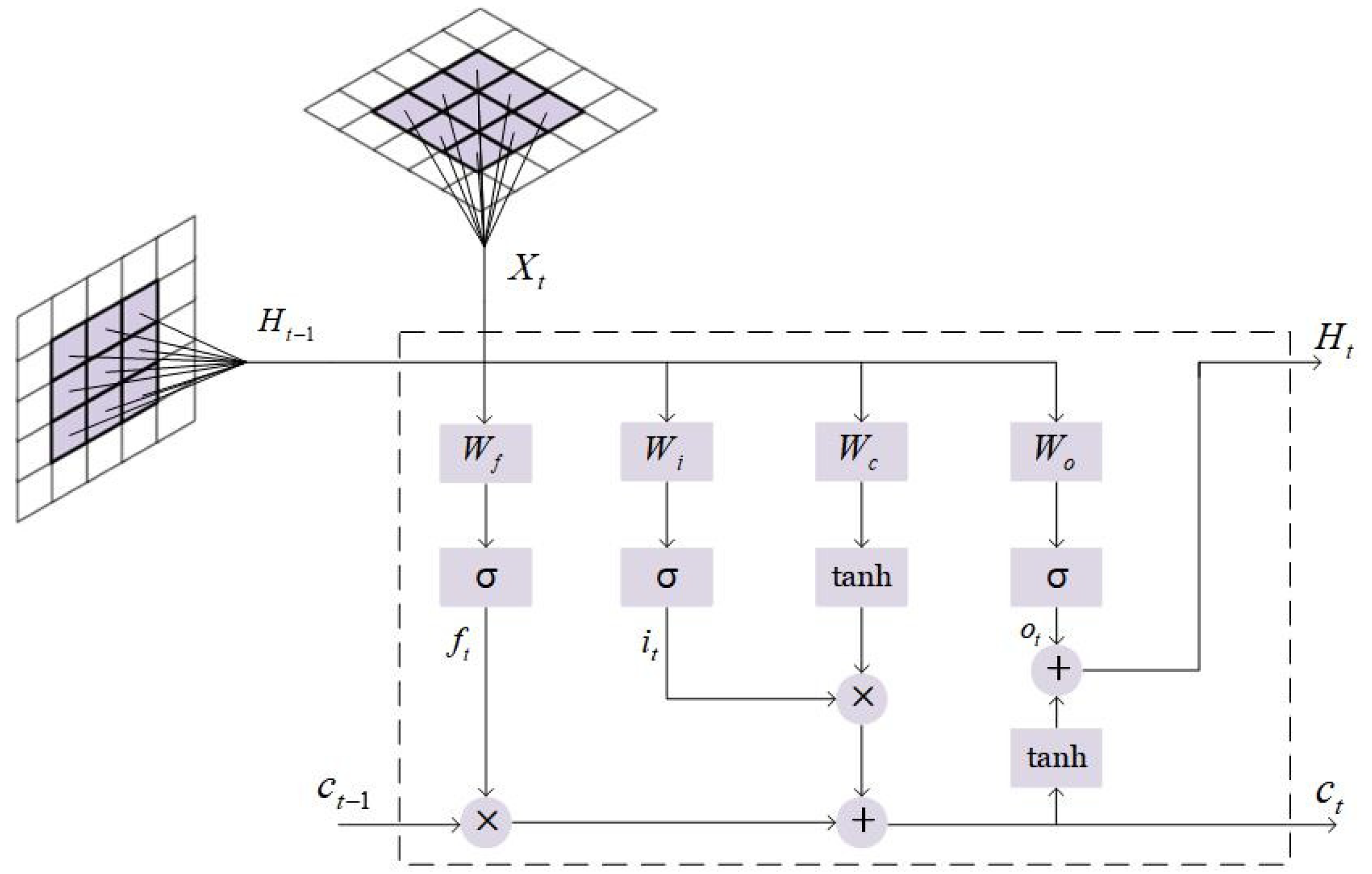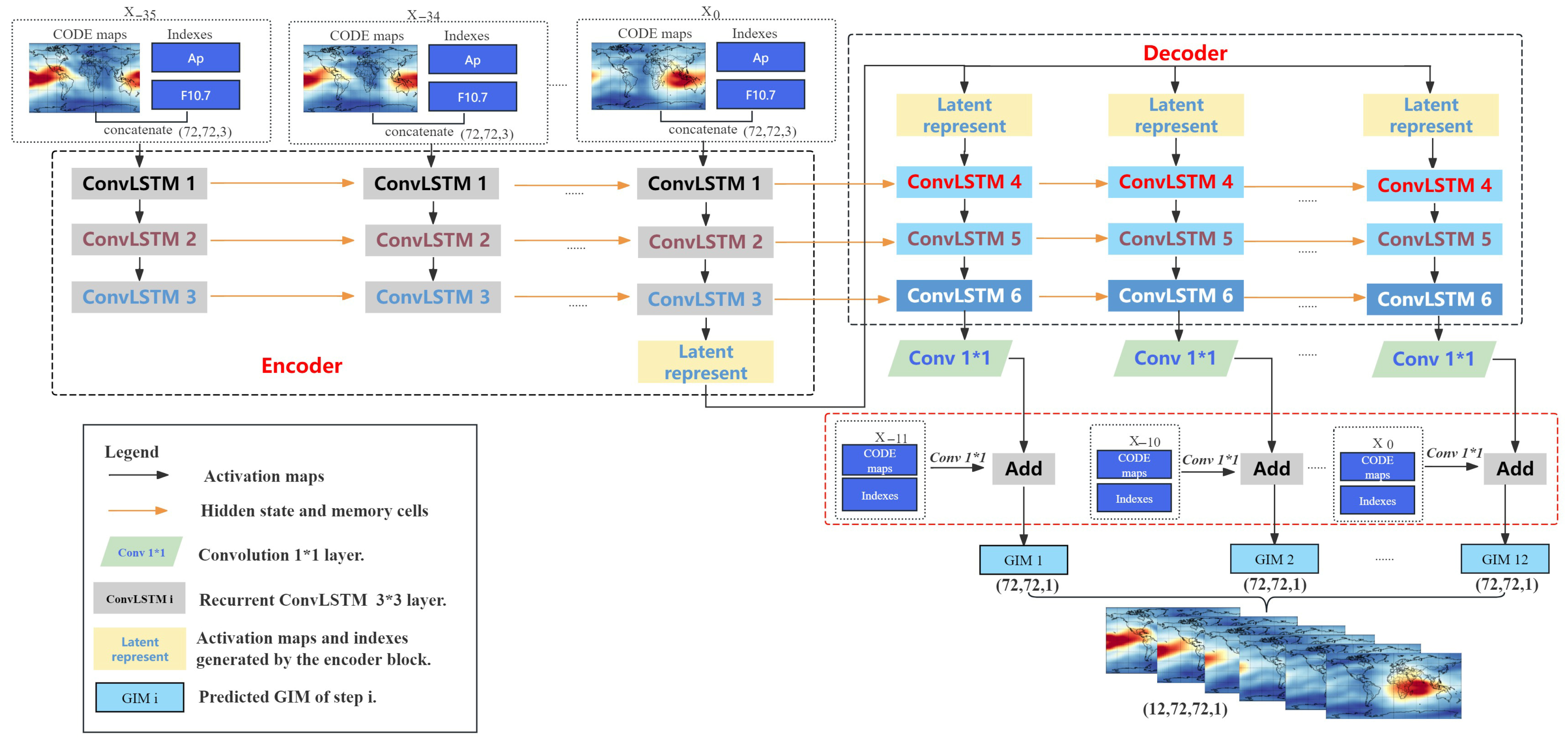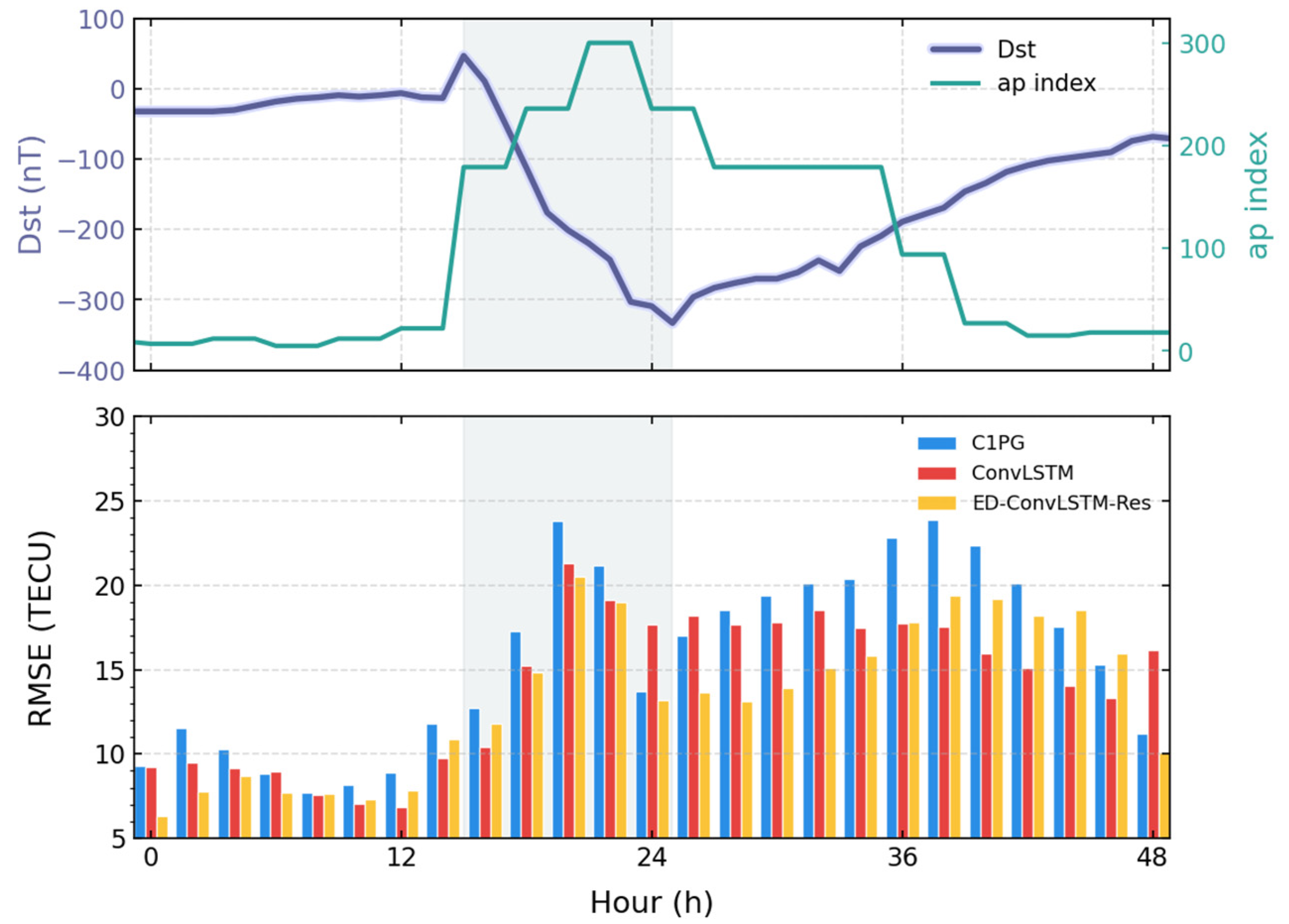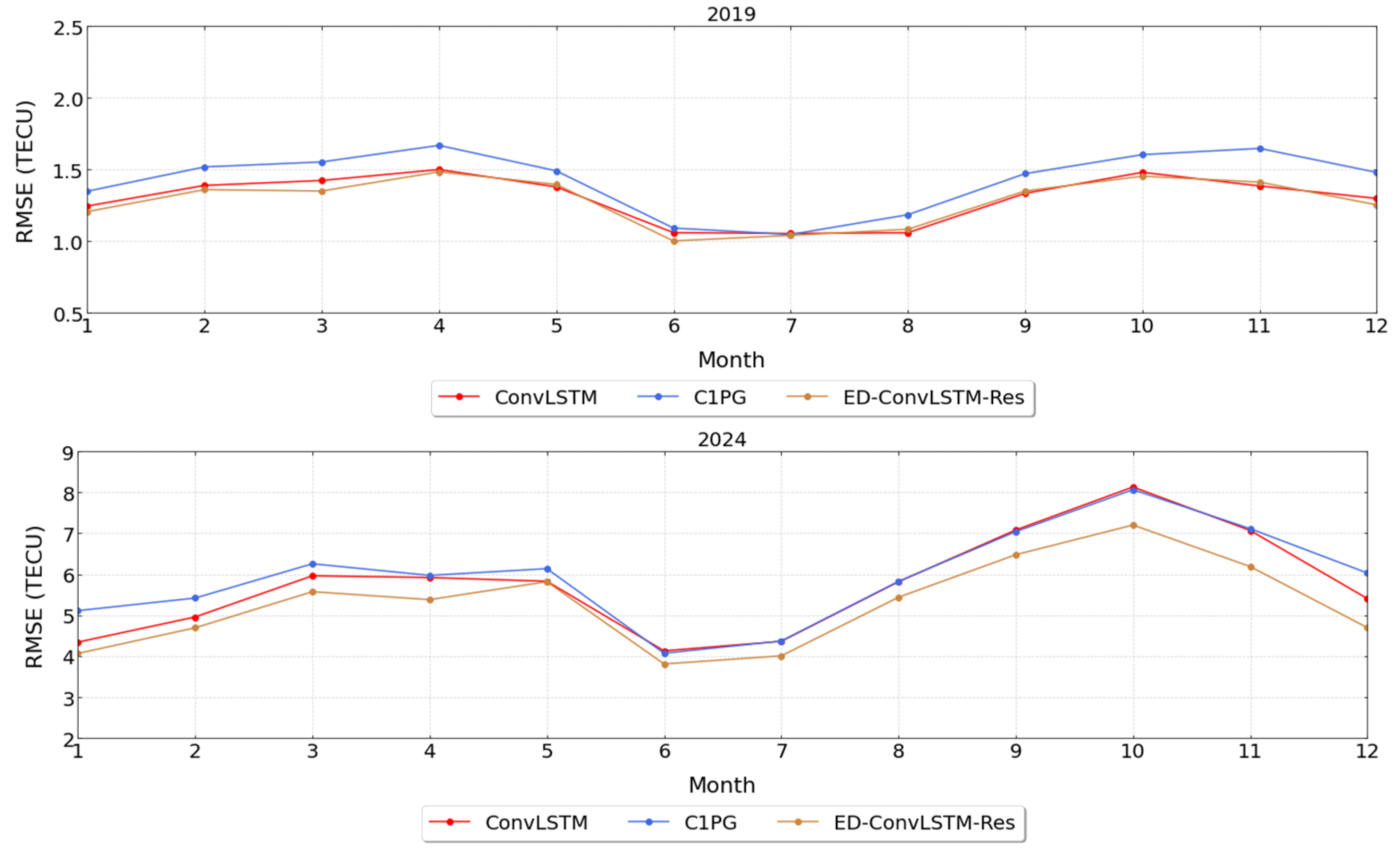Ionospheric TEC Forecasting with ED-ConvLSTM-Res Integrating Multi-Channel Features
Highlights
- The proposed ED-ConvLSTM-Res model, which integrates solar and geomagnetic activity indices as multi-channel features, consistently outperforms both the data-driven ConvLSTM model and CODE’s one-day-ahead forecast product c1pg.
- The model demonstrates strong spatiotemporal feature representation, achieving RMSE values of 1.28 TECU in 2019 (low solar activity year) and 5.28 TECU in 2024 (current high solar activity year), and substantially reducing prediction errors compared to the other two models.
- The ED-ConvLSTM-Res framework, enhanced with solar and geomagnetic indices as auxiliary parameters, provides a reliable and high-precision tool for global ionospheric TEC forecasting, with implications for space weather prediction, satellite-based navigation, and communication systems.
Abstract
1. Introduction
2. Data and Methods
2.1. Data Description
2.2. ED-ConvLSTM-Res Network
2.3. Evaluation Metrics
3. Results
4. Conclusions
Author Contributions
Funding
Data Availability Statement
Acknowledgments
Conflicts of Interest
References
- Bust, G.S.; Mitchell, C.N. History, Current State, and Future Directions of Ionospheric Imaging. Rev. Geophys. 2008, 46. [Google Scholar] [CrossRef]
- Kaselimi, M.; Voulodimos, A.; Doulamis, N.; Doulamis, A.; Delikaraoglou, D. A Causal Long Short-Term Memory Sequence to Sequence Model for TEC Prediction Using GNSS Observations. Remote Sens. 2020, 12, 1354. [Google Scholar] [CrossRef]
- Winglee, R.M.; Chua, D.; Brittnacher, M.; Parks, G.K.; Lu, G. Global Impact of Ionospheric Outflows on the Dynamics of the Magnetosphere and Cross-Polar Cap Potential. J. Geophys. Res. Space Phys. 2002, 107, SMP 11-1–SMP 11-12. [Google Scholar] [CrossRef]
- Wang, X.; Aa, E.; Chen, Y.; Zhang, J.; Zhu, Y.; Cai, L.; Lu, X.; Luo, B.; Liu, S.; Li, M.; et al. Mid-latitude neutral wind response during the mother’s day super-intense geomagnetic storm in 2024 using observations from the Chinese meridian project. J. Geophys. Res. Space Phys. 2025, 130, e2024JA033574. [Google Scholar] [CrossRef]
- Karpov, I.V.; Karpov, M.I.; Borchevkina, O.P.; Yakimova, G.A.; Koren’kova, N.A. Spatial and Temporal Variations of the Ionosphere during Meteorological Disturbances in December 2010. Russ. J. Phys. Chem. B 2019, 13, 714–719. [Google Scholar] [CrossRef]
- Zhang, R.; Li, H.; Shen, Y.; Yang, J.; Li, W.; Zhao, D.; Hu, A. Deep Learning Applications in Ionospheric Modeling: Progress, Challenges, and Opportunities. Remote Sens. 2025, 17, 124. [Google Scholar] [CrossRef]
- Ren, X.; Zhao, B.; Ren, Z.; Wang, Y.; Xiong, B. Deep Learning-Based Prediction of Global Ionospheric TEC During Storm Periods: Mixed CNN-BiLSTM Method. Space Weather 2024, 22, e2024SW003877. [Google Scholar] [CrossRef]
- Ruwali, A.; Kumar, A.J.S.; Prakash, K.B.; Sivavaraprasad, G.; Ratnam, D.V. Implementation of Hybrid Deep Learning Model (LSTM-CNN) for Ionospheric TEC Forecasting Using GPS Data. IEEE Geosci. Remote Sens. Lett. 2021, 18, 1004–1008. [Google Scholar] [CrossRef]
- Liu, L.; Morton, Y.J.; Liu, Y. ML Prediction of Global Ionospheric TEC Maps. Space Weather 2022, 20, e2022SW003135. [Google Scholar] [CrossRef]
- Jeong, S.; Lee, W.K.; Kil, H.; Jang, S.; Kim, J.; Kwak, Y. Deep Learning-Based Regional Ionospheric Total Electron Content Prediction—Long Short-Term Memory (LSTM) and Convolutional LSTM Approach. Space Weather 2024, 22, e2023SW003763. [Google Scholar] [CrossRef]
- Xia, G.; Zhang, F.; Wang, C.; Zhou, C. ED-ConvLSTM: A Novel Global Ionospheric Total Electron Content Medium-Term Forecast Model. Space Weather 2022, 20, e2021SW002959. [Google Scholar] [CrossRef]
- Yang, J.; Huang, W.; Xia, G.; Zhou, C.; Chen, Y. Operational Forecasting of Global Ionospheric TEC Maps 1-, 2-, and 3-Day in Advance by ConvLSTM Model. Remote Sens. 2024, 16, 1700. [Google Scholar] [CrossRef]
- Lee, S.; Ji, E.; Moon, Y.; Park, E. One-Day Forecasting of Global TEC Using a Novel Deep Learning Model. Space Weather 2021, 19, 2020SW002600. [Google Scholar] [CrossRef]
- Xue, K.; Shi, C.; Wang, C. RA-ConvLSTM: Recurrent-Architecture Attentional ConvLSTM Networks for Prediction of Global Total Electron Content. Space Weather 2025, 23, e2024SW004173. [Google Scholar] [CrossRef]
- Pesnell, W.D. Lessons Learned from Predictions of Solar Cycle 24. J. Space Weather Space Clim. 2020, 10, 60. [Google Scholar] [CrossRef]
- Hamid, R.H.; Marzouk, B.A. Forecasting the Peak of the Present Solar Activity Cycle 24. NRIAG J. Astron. Geophys. 2018, 7, 15–19. [Google Scholar] [CrossRef]
- De Paulo, M.C.M.; Marques, H.A.; Feitosa, R.Q.; Ferreira, M.P. New Encoder–Decoder Convolutional LSTM Neural Network Architectures for next-Day Global Ionosphere Maps Forecast. GPS Solut. 2023, 27, 95. [Google Scholar] [CrossRef]
- Guo, G.; Zhang, T. A Residual Spatio-Temporal Architecture for Travel Demand Forecasting. Transp. Res. Part C Emerg. Technol. 2020, 115, 102639. [Google Scholar] [CrossRef]
- Wang, C.; Xue, K.; Shi, C. An Optimized Model With Encoder-Decoder ConvLSTM for Global Ionospheric Forecasting. IEEE Geosci. Remote Sens. Lett. 2025, 22, 1–5. [Google Scholar] [CrossRef]
- Li, Y.; Deng, H.; Xiao, J.; Li, B.; Han, T.; Huang, J.; Liu, H. ED-SA-ConvLSTM: A Novel Spatiotemporal Prediction Model and Its Application in Ionospheric TEC Prediction. Mathematics 2025, 13, 1986. [Google Scholar] [CrossRef]
- Laštovička, J. On the Role of Solar and Geomagnetic Activity in Long-Term Trends in the Atmosphere–Ionosphere System. J. Atmos. Sol.-Terr. Phys. 2005, 67, 83–92. [Google Scholar] [CrossRef]
- Wang, X.; Miao, J.; Aa, E.; Ren, T.; Wang, Y.; Liu, J.; Liu, S. Statistical analysis of Joule heating and thermosphere response during geomagnetic storms of different magnitudes. J. Geophys. Res. Space Phys. 2020, 125, e2020JA027966. [Google Scholar] [CrossRef]
- Wang, X.; Miao, J.; Lu, X.; Aa, E.; Liu, J.; Wang, Y.; Liu, S. Latitudinal impacts of joule heating on the high-latitude thermospheric density enhancement during geomagnetic storms. J. Geophys. Res. Space Phys. 2021, 126, e2020JA028747. [Google Scholar] [CrossRef]
- Matzka, J.; Stolle, C.; Yamazaki, Y.; Bronkalla, O.; Morschhauser, A. The Geomagnetic Kp Index and Derived Indices of Geomagnetic Activity. Space Weather 2021, 19, e2020SW002641. [Google Scholar] [CrossRef]
- Tapping, K.F. The 10.7 Cm Solar Radio Flux (F10.7). Space Weather 2013, 11, 394–406. [Google Scholar] [CrossRef]
- Paularena, K.I.; Szabo, A.; Richardson, J.D. Coincident 1.3-year Periodicities in the Ap Geomagnetic Index and the Solar Wind. Geophys. Res. Lett. 1995, 22, 3001–3004. [Google Scholar] [CrossRef]
- Shi, X.; Chen, Z.; Wang, H.; Yeung, D.-Y.; Wong, W.; Woo, W. Convolutional LSTM Network: A Machine Learning Approach for Precipitation Nowcasting. In Proceedings of the 29th International Conference on Neural Information Processing Systems, Montreal, QC, Canada, 7–12 December 2015. [Google Scholar]
- Gonzalez, W.D.; Joselyn, J.A.; Kamide, Y.; Kroehl, H.W.; Rostoker, G.; Tsurutani, B.T.; Vasyliunas, V.M. What Is a Geomagnetic Storm? J. Geophys. Res. Space Phys. 1994, 99, 5771–5792. [Google Scholar] [CrossRef]
- Fuller-Rowell, T.J.; Codrescu, M.V.; Moffett, R.J.; Quegan, S. Response of the Thermosphere and Ionosphere to Geomagnetic Storms. J. Geophys. Res. Space Phys. 1994, 99, 3893–3914. [Google Scholar] [CrossRef]








| Network | c1pg | ConvLSTM | ED-ConvLSTM-Res | |
|---|---|---|---|---|
| 2019 | MAE | 1.02 ± 0.04 | 0.90 ± 0.04 | 0.87 ± 0.04 |
| RMSE | 1.43 ± 0.06 | 1.30 ± 0.06 | 1.28 ± 0.05 | |
| R2 | 0.94 ± 0.01 | 0.95 ± 0.01 | 0.95 ± 0.01 | |
| 2024 | MAE | 4.48 ± 0.27 | 4.21 ± 0.27 | 3.87 ± 0.28 |
| RMSE | 5.97 ± 0.36 | 5.75 ± 0.37 | 5.28 ± 0.37 | |
| R2 | 0.93 ± 0.01 | 0.93 ± 0.01 | 0.94 ± 0.01 | |
| Year | 2015 | 2019 | 2024 |
|---|---|---|---|
| Annual mean F10.7 (sfu) | 117.5 | 69.7 | 190.7 |
| Annual mean sunspot number | 70.4 | 3.7 | 147.4 |
| Geomagnetically active periods (Kp = 4) | 284 | 101 | 208 |
| Minor and moderate storm period (Kp = 5, 6) | 177 | 36 | 92 |
| Strong storm period (Kp = 7, 8) | 12 | 1 | 32 |
| Extreme storm period (Kp = 9) | 0 | 0 | 7 |
| Maximum Ap value | 117 | 45 | 273 |
| Maximum Kp value | 8 | 7 | 9 |
Disclaimer/Publisher’s Note: The statements, opinions and data contained in all publications are solely those of the individual author(s) and contributor(s) and not of MDPI and/or the editor(s). MDPI and/or the editor(s) disclaim responsibility for any injury to people or property resulting from any ideas, methods, instructions or products referred to in the content. |
© 2025 by the authors. Licensee MDPI, Basel, Switzerland. This article is an open access article distributed under the terms and conditions of the Creative Commons Attribution (CC BY) license (https://creativecommons.org/licenses/by/4.0/).
Share and Cite
Yang, J.; Huang, W.; Zhang, L.; Xu, H.; Shen, H.; Wang, X.; Li, M. Ionospheric TEC Forecasting with ED-ConvLSTM-Res Integrating Multi-Channel Features. Remote Sens. 2025, 17, 3564. https://doi.org/10.3390/rs17213564
Yang J, Huang W, Zhang L, Xu H, Shen H, Wang X, Li M. Ionospheric TEC Forecasting with ED-ConvLSTM-Res Integrating Multi-Channel Features. Remote Sensing. 2025; 17(21):3564. https://doi.org/10.3390/rs17213564
Chicago/Turabian StyleYang, Jiayue, Wengeng Huang, Lei Zhang, Heng Xu, Hua Shen, Xin Wang, and Ming Li. 2025. "Ionospheric TEC Forecasting with ED-ConvLSTM-Res Integrating Multi-Channel Features" Remote Sensing 17, no. 21: 3564. https://doi.org/10.3390/rs17213564
APA StyleYang, J., Huang, W., Zhang, L., Xu, H., Shen, H., Wang, X., & Li, M. (2025). Ionospheric TEC Forecasting with ED-ConvLSTM-Res Integrating Multi-Channel Features. Remote Sensing, 17(21), 3564. https://doi.org/10.3390/rs17213564





